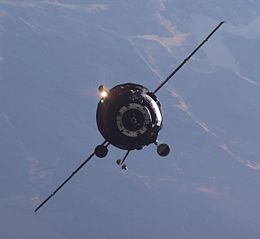cosmos.wikisort.org - Spacecraft
Progress M-53 (Russian: Прогресс М-53), identified by NASA as Progress 18P, was a Progress spacecraft used to resupply the International Space Station. It was a Progress-M 11F615A55 spacecraft, with the serial number 353.[1]
 Progress M-53 approaching the ISS. | |
| Mission type | ISS resupply |
|---|---|
| Operator | Roskosmos |
| COSPAR ID | 2005-021A |
| SATCAT no. | 28700 |
| Mission duration | 83 days |
| Spacecraft properties | |
| Spacecraft type | Progress-M s/n 353 |
| Manufacturer | RKK Energia |
| Start of mission | |
| Launch date | 16 June 2005, 23:09:34 UTC |
| Rocket | Soyuz-U |
| Launch site | Baikonur, Site 1/5 |
| End of mission | |
| Disposal | Deorbited |
| Decay date | 7 September 2005, 14:12:40 UTC |
| Orbital parameters | |
| Reference system | Geocentric |
| Regime | Low Earth |
| Perigee altitude | 351 km |
| Apogee altitude | 353 km |
| Inclination | 51.6° |
| Period | 91.0 minutes |
| Docking with ISS | |
| Docking port | Zvezda aft |
| Docking date | 19 June 2005, 00:41:31 UTC |
| Undocking date | 7 September 2005, 10:25:57 UTC |
| Time docked | 80 days |
| Cargo | |
| Mass | 2500 kg |
Progress ISS Resupply | |
Launch
Progress M-53 was launched by a Soyuz-U carrier rocket from Site 1/5 at the Baikonur Cosmodrome. Launch occurred at 23:09:34 UTC on 16 June 2005.[1]
Docking
The spacecraft docked with the aft port of the Zvezda module at 00:41:31 UTC on 19 June 2005.[2][3] The docking was conducted using the backup TORU system, under the control of cosmonaut Sergei Krikalev, due to a power failure at one of the spacecraft's ground control stations.[4] It remained docked for 80 days before undocking at 10:25:57 UTC on 7 September 2005[2] to make way for Progress M-54.[4] It was deorbited at 13:26:00 UTC on 7 September 2005.[2] The spacecraft burned up in the atmosphere over the Pacific Ocean, with any remaining debris landing in the ocean at around 14:12:40 UTC.[2][5]
Progress M-53 carried supplies to the International Space Station, including food, water and oxygen for the crew and equipment for conducting scientific research.
See also
- List of Progress flights
- Uncrewed spaceflights to the International Space Station
References
- McDowell, Jonathan. "Launch Log". Jonathan's Space Page. Retrieved 6 June 2009.
- Anikeev, Alexander. "Cargo spacecraft "Progress M-53"". Manned Astronautics - Figures and Facts. Archived from the original on 12 October 2007. Retrieved 6 June 2009.
- Wade, Mark. "Progress M". Encyclopedia Astronautica. Archived from the original on 3 August 2009. Retrieved 6 June 2009.
- Zak, Anatoly. "Progress cargo ship". RussianSpaceWeb. Retrieved 6 June 2009.
- McDowell, Jonathan. "Satellite Catalog". Jonathan's Space Page. Retrieved 6 June 2009.
На других языках
- [en] Progress M-53
[ru] Прогресс М-53
Прогресс М-53 — транспортный грузовой космический корабль (ТГК) серии «Прогресс», запущен к Международной космической станции. 18-й российский корабль снабжения МКС.[1] Серийный номер 353.Другой контент может иметь иную лицензию. Перед использованием материалов сайта WikiSort.org внимательно изучите правила лицензирования конкретных элементов наполнения сайта.
WikiSort.org - проект по пересортировке и дополнению контента Википедии
